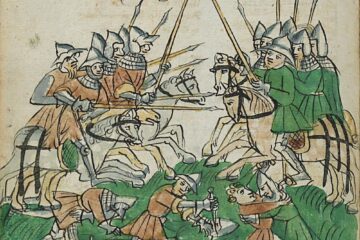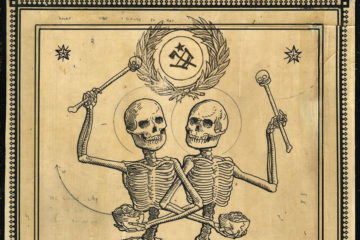by Leech Elisabeth Ashyver, Medicus in the Rosewood Infirmary
I hope that this book finds whoever reads it in good health. This book is a guide to the many things a medicus needs to know to be able to properly tend to someone. May this guide along with the Lord’s divine intervention aid you in administering adequate treatment and care to the sick and injured. May it also be your light that, with its brightness, you are able to cope with the tenebrous aspect of death and grief. For we are all mortals in God’s kingdom waiting to be recollected, we must know that whoever it is that passed, their time had come.
Chapter 1: small cuts, large battle wounds and annoying sores in between
Cuts and scrapes may seem small but can bring down the greatest of warriors. Firstly, it’s best to ascertain how the wound came about and figure where it is. Once the cut is found you need to make sure infection does not take hold. An infection, if left to fester will most likely kill your poor patient before the wound itself does. Thus it’s important to clean the wound first before closing it by stitching or otherwise. I suggest to cut a fresh lemon and use it to cure the cut before washing it with clean water. Moving on to larger wounds there are two simple ways to close them, first the simple stitch for smaller wounds and the process of burning larger wounds closed which is called cauterizing the wound. Though it is different for all times of wounds, for a sword it’s normally just the one hole but for an arrow is completely different. When extracting an arrow, there were three guidelines that were to be followed. A medicus should first examine the position of the arrow and the degree to which its parts are visible, the possibility of it being poisoned, the location of the wound, and the possibility of infection. The second rule is to extract it delicately and swiftly. The third rule is to stop the flow of blood from the wound. The arrowheads that are commonly used against troops are typically not barbed or hooked, but they are slim and designed to penetrate armor such as chain mail. Although this design may be useful as wounds are smaller, these arrows are more likely to embed in bone which makes them harder to extract. If the arrow happened to be barbed or hooked it made the removal more challenging. A medicus would then let the wound purify, thus making the tissue softer and easier for arrow extraction. Animal bites can be a risky thing as most feral beasts will leave infections if left untreated. The most important thing to do when someone is bitten by the animal is to clean the wound, use lemon, honey, or ale to stop any infections before wrapping the wound with a clean bandage.
Chapter 2: stitches, cauterizing, bone breakage and amputations
From stitching to the cutting of limbs, Medici have passed down the information and techniques from generation to generation on how to clean and fix wounds; it must be said that all three of the main techniques fall into an order with stitching being used for smaller cuts, cauterizing for bigger cuts, and amputations being a more or less last-ditch effort to save someone’s life which, sadly is not always guaranteed at that point. But let’s start with stitching. Stitching is the easiest way to close a wound, you should have practiced stitching in your early years of the church so it should become second nature if you want to become a medicus worthy of your title. The first thing you are going to want to do is heat up the tip of the needle so that it passes through the flesh a lot easier as-well-as make sure that there are no infections going into the body, remember to tie a knot on the thread so it stays in as well. Now you are going to want to do a simple weave before cutting off the cord then using a linen bandage to cover the wound, make sure your patient stays in the infirmary for a day or so to make sure the string does not break and remind them not to pick at it. As for cauterizing It is most definitely one of our more painful techniques as it’s burning the wound close with a red hot dagger, I suggest giving the patient a stick to bite down on so that they don’t scream or bite their tongue clean off. The best way to go about doing it is to hold a dagger or an iron of suitable shape to a fire until it is bright red. Then all that’s left is to clean then dry the wound and steady your hand as-well-as yourself before slowly but firmly placing the flat side of the dagger down onto the open wound. Leave it for a few moments and then pull the dagger away and place it into a bucket of water to cool off. You will want to get it right the first time so make sure you supply enough pressure in the first place so as to not need to repeat the procedure, cover the wound with a bandage, and regularly check in with the patient. The second most painful procedure a medicus can do is to reset broken or shattered bones. Resetting bones can be a hard task as the patent tends to move around a lot which can make it hard to relocate dislocated bone as-well-as reset bones. In reaction to the injury with arms, the muscles contract and are stretched before the bone can be set. Arm muscles do not offer undue resistance. Thus the bone of a forearm can be set without too much exertion on the part of the medicus. Once set and placed in a sling, the arm bone requires time and rest for healing. With legs though it is a bit more difficult, the muscles are a lot stronger so your patient needs to relax; I suggest giving them ale and numbing the joint with a paste of yarrow. Now we come to the more or less most painful procedure a medicus can perform, the act of amputating. Let it be said now that amputation should never be the first thing you go to as it obviously cripples your patient for the rest of their lives and there it is not guaranteed they will survive in the first place. Typically it takes less than a minute for a medicus to remove a damaged limb, and another three to four minutes to stop the bleeding. You should first place the limb on a block of wood and tie ligatures above and below the site of surgery. Then the soft tissue would be cut through, thus exposing the bone, which was then sawed through. The stump was then bandaged and left to heal. If the situation allows for it, heat up a blade or oil in order to close the wound before bandaging it. Also don’t expect the patient to be awake during this procedure since the pain will most likely knock them out.
Chapter 3: major herbs and remedies and how to make them
A Medicus’s job is half spent closing wounds and half spent making remedies for your average pain and annoyance, though the two halves are very intertwined. First and foremost there are many lists stored on the shelves inside the infirmary that point to jars and boxes of herbs, ointments and gels inside jars and it’s a good idea to become accustomed to the all though you will want to know more about a few cures for things like headaches, burns, stomachaches, and many other things. A few of the main herbs that I use are wormweed, angelica to aid digestion, borage for respiratory and stomach ailment, and St John’s wort to ease bruises and burns, and poppies for great pains. Now that we have the covered some of the major herbs you should also know to effectively use them in your everyday lives though I won’t go into depth on all the minor plants in this chapter though if you would like to know then there should be a label on each jar telling you what the herb does though I will tell you some that you should know. First off I personally like to always use wormweed for dulling pain in any wound. The best way to take it is to eat the root with a glass of water or ale. Now another useful herb is Mugwort, mugwort is used mostly for woman’s bleeding and it should be digested as well. St John’s wort, however, is used by mashing it up then adding a small amount of water to create a paste-like substance. You will want to apply the paste straight to the wound and leave for about an hour before any real effect can be seen so don’t worry if it does not seem to work right away. Artemisia is a good substitute for ale in the infirmary to dull pain. Artemisia can be found in the forest surrounding Rosewood and can be distinguished from other plants from its long straight stem with large round silverish leaves, you will want to cut off the yellow tubular flowers that grow at the top of the plant, once you have about three or four of the yellowish flower simply brew them for an hour to create a cheap but useful substitute to ale or beer. Aconite is a rarer thing to find in an infirmary as it is well known as the queen of poisons, though many have made the mistake of eating the poisonous flower others have figured out how to use it appropriately. By simply grinding the flower with a leaf of yarrow and a bundle of monksbane a concoction that can help keep the fear of sleeping at bay can be made. If you want to know more about some of the more common roots and plants we use, besides this text I have left a list off one of the Shelves inside the infirmary to show you how they are clearly labeled though you will do well to be able to remember them all as-well-as their uses and drawbacks if you would like to become an efficient medicus.
Chapter 4: dealing with death and infirmary etiquette
In every medicus’ life, there will come a time when you lose somebody, be it by sword stroke or by infection. The best way to break it to loved ones or friends is always be gentle and caring, always remember they just lost a loved one or there is something wrong and they don’t need a cold shoulder or a cold-hearted medicus to tell them such. Best to always tell a priest before telling love ones so the body can be prepared for burial. But onto a lesser but still important topic infirmary etiquette. A medicus is a child of the Lord at all times and must dress properly at all times to show that we are dignified, the simple white gown we wear will suffice as your outfit when you are working. But another thing to remember is that the infirmary must always remain clean, never track dirt on the floors as a dirty infirmary is an ill infirmary. Going along with this all jars and pots need to be put away after use in the right spot, a bone saw out of place can become a danger, an annoyance or could cost someone their life so if you take something remember where you took it from. Another thing to be careful of is the patients habit to go mad when say see their own blood, it is known that a cut can look worse than it actually is but the mind will play tricks, best to distract them at all costs or have another medicus do so when you are working, it could be a good idea do feed them bread soaked with ale to calm their nerves before anything happens. It should go without saying that an infirmary’s meals are very bland. To keep costs at a low but also make sure that they have enough energy to heal the meals that are given out to all patents are oats and pottages, goat’s cheese, bread, and meat if the year is good, often with lemon. It is also known that the four humors, yellow bile, black bile, phlegm, and blood need to be kept in balance. The best way to make sure it stays balanced is to perform bloodletting on the patient. Simply grab a leech which is kept in a pool situated on the outside of the infirmary and place it on the bloodways of the patient.
Chapter 5: a medicus’ job on the battlefield
Though I wish that our job never came to such things a medicus must be prepared to work on a battlefield, you must always remember that you have to keep yourself alive first. That means not taking weapons or armor which might make a marksman think you to be a soldier. Though we used to wait till go pick up the injured till after the battle was done we now go out and seek the injured, you must remember that’s it’s our job to help anyone we come across. Be it friend or foe. The most common injuries in battle are burns, sword wounds, arrow wounds, and most other weapons too. We covered how to deal with wounds like arrows and swords but in this chapter, we will be covering burns. A burn or blister can be prevented from becoming dry by using ointments or oils placed on the burn. These ointments typically consisted of vinegar, egg, rose oil, poppy, and wormweed which were then mixed into a red-colored liquid. If the liquid is made properly, dip a rag or bandage into it till it’s soaked then apply to the wound and keep there for a day. Even though it’s your job to heal those on a battlefield it can be hard as you need to make a choice if a person can be healed or not, remember if you take one man another may die by the time you get back so you must avail yourself to proper and logical judgment and make the choice of who you are going to save. It should also be brought to mind that saving higher-ups should be a priority though if there is no hope then you must move on and search for those still among the living. Keep in mind that performing the short version of the last right is allowed but must be done quickly to ensure that both it is heard before they pass and so that the leech can keep moving.
This marks the end of what I hope is a helpful book for an aspiring medicus. If something has not been said in the book that you would like to know, remember that any of the medicus around you will always be there to help as-well-as the Lord. Remember that our heavenly Lord has set a path for all of us and you will do well to stay on it and I wish you blessings and good luck. And finally, experiment. Do not be afraid to try new things. For everything can be used to help men and women, if we know how it works.
At the time of me writing this, a squire has died, to the medicus who finds the book in whatever age they are reading this, I pray that it finds them well. Remember my brothers and sisters that the Lord has a plan for us all and if we don’t stray then we will be led to His Kingdom in the end. Do not give up and stand firmly in the face of pain and misery.
Sursum corda


